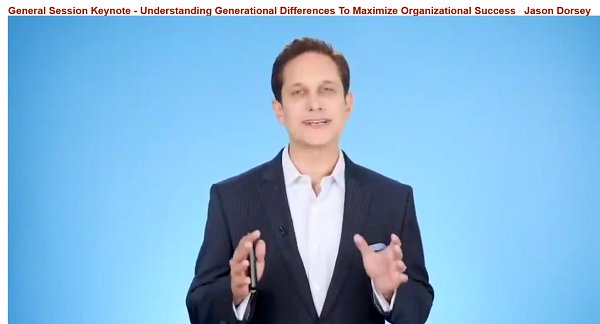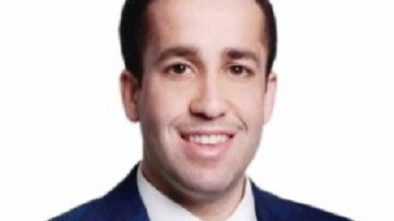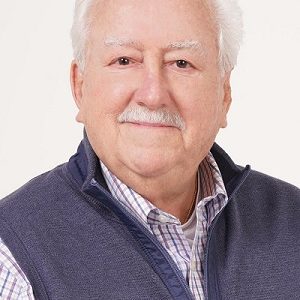At EdgeCon, a Different Take on Multigenerational Workforces
EdgeCon, the annual conference of Edge (Newark), a regional nonprofit technology consortium, took place virtually this month. And one of its most dynamic speakers was Jason Dorsey, who gave his perspective on how to understand multigenerational workforces.
Dorsey is a bestselling author and global researcher who’s widely known for debunking generational myths and uncovering hidden trends. His company, the Center for Generational Kinetics (Austin, Texas), is very data centric, he said.
CGK sees generations a little differently than most. It defines a generation as “a segment of a geographically linked population that experiences similar social and cultural events at roughly the same time in their maturation, leading to similar responses by scenario.” According to Dorsey, this means that a generation is a group of people that share two things: they’re born about the same time and they are raised in about the same place. He said that knowing this about people gives clues to their behavior.
The number-one thing that shapes generations is parenting. “Parenting styles present lots of information in terms of the messaging that is going to young adults today, as they choose to move forward.”
Also, where you were in your life when new technology was introduced influences behavior. “Technology is only new if you remember it the way it was before,” Dorsey said. He then spoke about a company that figured out how to pay its workers half of their earnings every day, with the remainder paid out on the usual schedule.
“Why is this important when you think about technology? You have a whole generation of young adults today, under the age of 20ish, that will never remember a time before they could get paid every single day.” They won’t wait two weeks or a month. They will think it’s normal to get paid every day.
While business owners think that Generation Z (born in 1996 or later) and millennials (born in 1977-1995) represent upheaval and change, they themselves don’t think they represent change at all. “All they’re doing is bringing what’s normal to them into a workforce or into an education setting, or into adulthood. It represents change to everybody else, but it doesn’t actually represent change to them,” he said. Change would be asking them to put a letter in the mail or respond to an email.
One of our other key discoveries is that technology trends are starting with the youngest, and rippling up to the oldest, he told the online audience.
“Historically, technology trends were driven by those who were older, who were more affluent. They bought those technologies because they were expensive. That was a personal computer, or a Betamax or a fancy calculator. They had them first because they were expensive and, eventually, as it got cheaper, the technology would be driven down lower and lower and lower.” For the first time now, the younger generation is driving technology adoption.
Speaking about how cultural events affect generations, Dorsey noted that the event that defines millennials is September 11, 2001. They all know where they were at that moment. “That was our JFK assassination, if you will. That was the moment that stopped us in our tracks and created fear and uncertainty and caused us to look at the world differently.”
For his father, 9/11 brought up memories of the Vietnam draft, as he worried that his son would be drafted. For his grandfather, who was 80 at the time of 9/11, it was Pearl Harbor.
But Gen Z doesn’t remember 9/11. Gen Z came of age during the great recession. Gen Z is very conservative or practical with money, “way more so than what we’ve seen in millennials.” That means that they save for retirement and carry less school debt than millennials. They also want different things from employers, such as benefits and stability.
Millennials get the worst rap of any generation, yet they are the number-one generation in the U.S. workforce. Dorsey believes that millennials are a split generation. “You have one part of the generation doing everything they’re told to. … They go to work, get an education, become self-reliant, you name it. … Then you’ve got another part of the generation that’s struggling to create real-world traction.”
The millennials’ parents were the Baby Boomers (1946–1964), and Boomers had a particular parenting philosophy that came back to haunt them. They wanted it easier for their children than it had been for them. So, many millennials ended up wanting the freedom of being an adult, without the accompanying responsibilities, said Dorsey. They entered the workforce at an older age than any other generation, graduated from college later and got married later.
Right now, millennials are the number-one group driving home purchases. Most millennials are tech dependent and tech savvy. They want simplified tech. “By the time technology got to the millennials, it was all about the user interface.”
Generation X (born in 1965-1976) can be characterized as those who “trust, but verify,” he said. They are naturally skeptical. When Gen X came of age, the divorce rate was skyrocketing, he added. Also, a lot of women were entering the workforce. Gen Xers spent a lot of time alone, so they became very self-reliant.
It’s important to pay attention to Gen X, Dorsey said. “Gen X is right now deciding whether they are going to stay where they are and finish out their careers. Or, maybe on the other side of this pandemic, they are going to decide to go somewhere else and finish out their careers. They are deciding right now, and Gen X is the glue in the workforce, they are the bridge, they make phenomenal leaders because they’re into the data. They want to know where you got your data from.”
Every generation, Dorsey said, is experiencing the pandemic differently. The most impacted is Gen Z. The older members of Gen Z are between 18 and 24 years old. They came into the workforce or into higher education and “really crashed into a very difficult time on the higher ed side. Maybe they were told, ‘We’re only going to do remote learning,’ or ‘You can’t come to campus’ or ‘You’re here, and now you’ve got to go back home.’ If they were going to do an internship, they can’t do internships anymore. Maybe the career they’re going to go into is no longer a viable career because things have suddenly changed. So, the oldest members of Gen Z are really bearing the brunt of this. In fact, the research shows the number-one generation to lose their job during COVID-19 is Generation Z.”
Dorsey made some suggestions to college recruiters and hiring managers about how to approach the different generations:
- Make it easy for job candidates to save their applications. If they can’t save their applications, they will not apply. Treat an unfinished application like an abandoned cart, and send a text saying, “Hey Jason, I saw you started your application with us. We’d like to see if we are a good fit for you. Here is a link to complete the application.” Dorsey’s company has seen application completion go up by as much as 50 percent.
- Use SMS for outreach. Increasingly, every generation wants to be contacted by text message. They also want to be paid by text message.
- Millennials are outcome driven. So, if you are looking at millennials and nontraditional students, give them messages like “If you do these three things, you’ll be successful.” They want to know the outcome first, so work backwards with them on these steps. They will be massively compliant if they know the outcome first.
- Match your outreach medium to the generation. “Deliver ongoing communication aligned with each generation. This is so important! What’s great for somebody in printed communication another group may think is a waste of paper.”
- Hire and fire empathetically. “I was on a call yesterday and people were doing Zoom firings. … They would get 10 people on the same Zoom” and fire them all at once. Don’t do that. We’ve got to let people go with dignity and honor, empathy, respect, preferably one-on-one. You may not be able to do it in person, obviously, but at least do it in a way that shows them that you care about them and you’re respecting them as humans. Why is this important? It determines the attitude of those employees who get to stay.”



